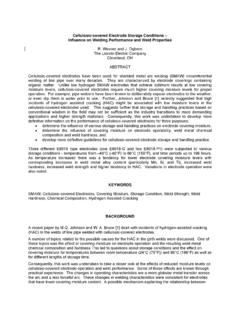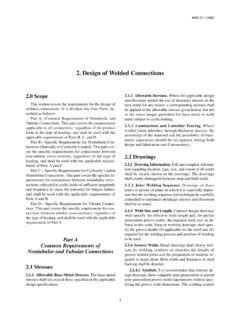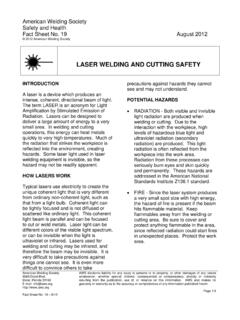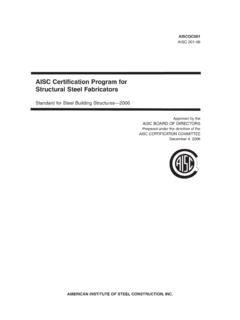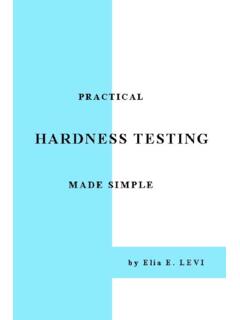Transcription of Avoiding Weld Failures Through Proper Understanding of ...
1 Avoiding weld Failures Through Proper Understanding of Load Transfer Omer W. Blodgett, , , The lincoln electric Company Introduction An Understanding of the transfer of load Through a weldment is essential in helping the design engineer to avoid or solve weld cracking problems. Several real-life examples serve to illustrate important design principles. Re-evaluate Any Design Change Many engineers are not aware of the possibility of a crater crack at the end of a weld because this has never been a problem in a welded attachment to the flange of a rolled wide flange beam. Checking the transfer of force Through this weld will quickly show that most of this force will enter the web of the beam.
2 Since there is little transfer of force at the ends of the weld , even a very poor weld crater would not present a problem. Today, however, box sections often are used in place of the wide flange beams. In such a case, the main load transfer into the webs of the box would be at the ends of the weld , meaning that a weld crater could create serious problems, and extra care must be taken to avoid a crater at the end of the weld . Furthermore, if lugs are welded to the flange of the box section, the applied force will be transferred into the two webs which form the sides of the box. To accomplish this, the bottom flange will bend or diaphragm, producing high bending stresses Through the thickness of the detail will be a good candidate for fatigue if the force is cyclic.
3 Don't Inadvertently Put Welds in Bending For example, there is a curved box beam used on a heavy truck to support a third rear axle. The fillet welds in the region of the curve have cracked. No one would purposely place a weld in bending, yet this is the problem. Under load when the third rear axle is down against the pavement, the curved box beam is subject to a changing bending moment. This causes a tensile force (F) to occur in the lower or inside flange. Because of the radius of curvature (r ) this causes a unit inward radial force to pull the flange inward toward the center of curvature. Because of the location of the two supporting webs, the inward flange deflects as a beam, the ends go upward and the center goes downward By moving the point of support of the flange (the web) inward a certain amount, a point is reached where the angle becomes zero, called the point of inflection in the structural field.
4 When the web is moved inward sufficiently, there is no rotation and the weld should not break. When Force Changes Direction When a force changes direction over a given length of arc there is a unit force set up along this length. In the structural field, the knee of a rigid frame is usually under negative moment. The inside flange is under compression and the unit radial force actually pushes the flange against the web, so weld size in this condition is not too critical. However, in a mechanical application, for example, a press, there is positive moment. The inside flange is under tension and the unit radial force actually is trying to pull the flange away from the web.
5 This became the reason for failure for a new 50 ton press using in. fillet welds. The allowable for a in. fillet weld using E70 weld metal is f = ( in.)(.707)(21 ksi) = K/in. The actual radial unit force in this case was found to be over 40 K/in. The weld split when the first load was applied, demonstrating that this radial force is very real and must be considered. Conclusion As these and many other examples illustrate, a thorough Understanding of load transfer is the key to Avoiding many types of weld Failures .
